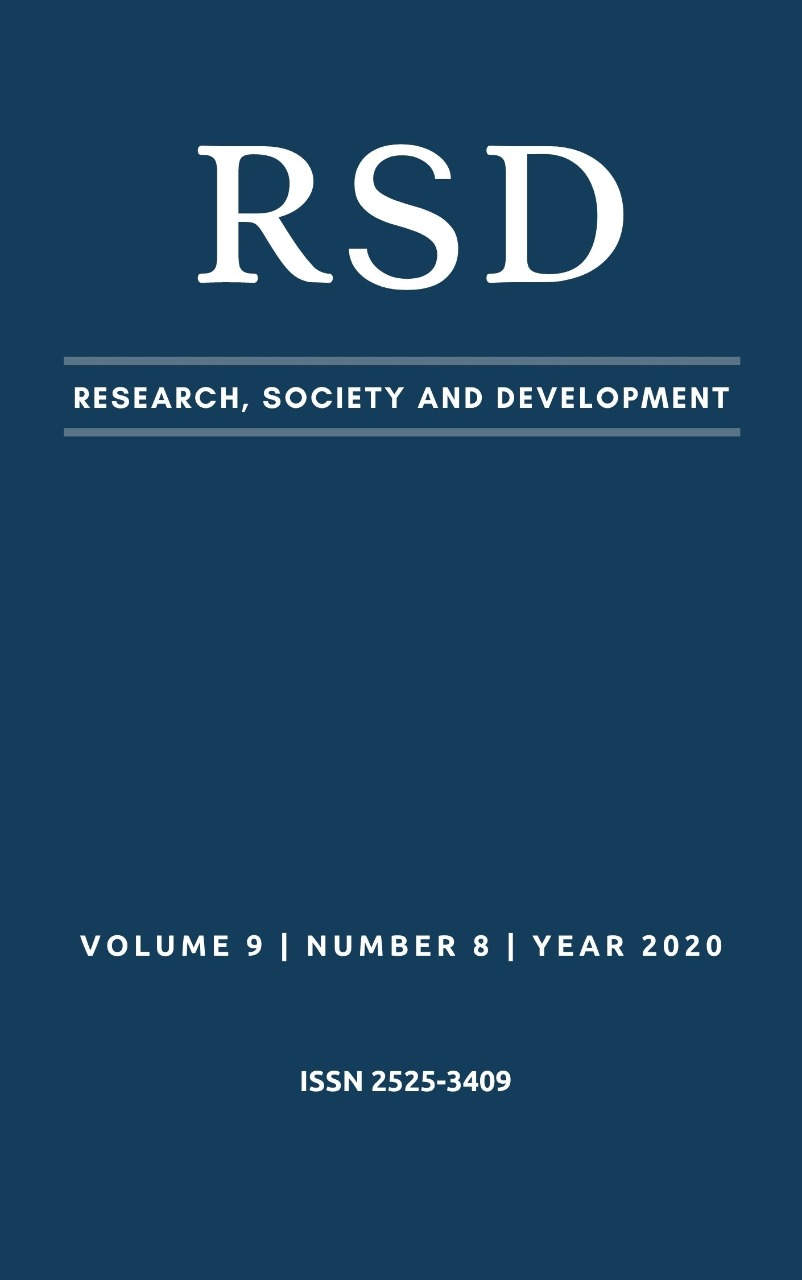La Importancia de las Guías de Enfermería para mujeres embarazadas com Enfermedad Hemolítica Perinatal: uma revisión integradora
DOI:
https://doi.org/10.33448/rsd-v9i8.6184Palabras clave:
Prenatal; Isoinmunización; Embarazo de alto riesgo; EnfermeríaResumen
Este estudio tiene como objetivo identificar las pautas previstas por la enfermera a la mujer embarazada, durante el cuidado prenatal y describir la influencia de estas pautas en la construcción del conocimiento de la mujer embarazada con la Enfermedad Hemolítica Perinatal. Se trata de una revisión integradora realizada en la base de datos de la Biblioteca Virtual de Salud, donde están disponibles los datos de LILACS, SciELO y Bdenf. Incluyeron se tres publicaciones entre 2011 y 2018 en la categoría Importancia de la educación de los clientes y los profesionales de la salud en el cuidado de la enfermedad hemolítica perinatal. Hemos observado que hay una gran falta de acceso a la información relevante para el cuidado prenatal y acerca de la patología en cuestión. En vista de ello, el estudio rescata la importancia de un cuidado prenatal de alto riesgo realizado concomitantemente por el profesional médico y la enfermera, ya que la enfermera, como educadora, puede ser un elemento clave en el proceso de remodelación del cuidado.
Citas
Araújo, L. A., & Reis, A. T. (2012). Enfermagem na prática materno-neonatal. Rio de Janeiro: Guanabara Koogan.
Baiochi, E., & Nardozza, L. M. M. (2009). Aloimunização. Revista Brasileira Ginecologia e Obstetrícia, 31(6), 311–319. doi: 10.1590/S0100-72032009000600008
Bolton-Maggs, P. H. B., Davies, T., Poles, D., & Cohen, H. (2013). Errors in anti-D immunoglobulin administration: Retrospective analysis of 15 years of reports to the UK confidential haemovigilance scheme. BJOG, 120(7), 873–878. doi: 10.1111/1471-0528.12175
Broome, M. E. (2000). Integrative literature reviews for the development of concepts. In Rodgers, B. L., Knafl, K. A. (Eds). Concept development in nursing: foundations, techniques and applications. Philadelphia (USA): W.B Saunders Company. 2000.
Eder, A. (2006). Update on HDFN: New information on long-standing controversies. Immunohematology, 22(4), 188–195. Recuperado de: https://pubmed.ncbi.nlm.nih.gov/17430078/
Ferreira, A. R., Jr., Oliveira, J. T. de, Filho, Albuquerque, R. A. de S., Siqueira, D. D., Rocha, F. A. A., & Rodrigues, M. E. N. G. (2018). O enfermeiro no pré-natal de alto risco: Papel profissional. Revista Baiana de Saúde Pública, 41(3). doi: 10.22278/2318-2660.2017.v41.n3.a2524
Geaghan, S. M. (2011). Diagnostic laboratory technologies for the fetus and neonate with isoimmunization. Review Semin Perinatol., 35(3), 148–154. doi: 10.1053/j.semperi.2011.02.009
Lopes, V. R. da S. (2013). Doença hemolítica: A atuação do enfermeiro enquanto cuidador e orientador. Anais do Fórum Científico FEMA, Assis, SP, Brasil, 4.
Medeiros, R. T. de, Bezerra, R. G., Menezes, R. M. P. de, Davim, R. M. B., & Carvalho, C. F. S. de. (2011). Utilização da vacina Rogan durante o pré-natal em mulheres Rh negativo: Conhecimento dos profissionais da saúde. Rev. Enferm. UFPE online; 5(5), 1193–1203. doi: 10.5205/reuol.1302-9310-2-LE.0505201115
Mendes, K. D. S., Silveira, R. C. de C. P., & Galvão, C. M. (2008). Revisão integrativa: Método de pesquisa para a incorporação de evidências na saúde e na enfermagem. Texto Contexto Enferm., 17(4), 758–764. doi: 10.1590/S0104-07072008000400018
Ministério da Saúde. (2013). Atenção ao pré-natal de baixo risco. (1a ed. rev.). (Cadernos de Atenção Básica, nº 32).
Ministério da Saúde. (2012). Gestação de Alto Risco: Manual Técnico. (5a ed.).
Ministério da Saúde. (2001). Parto, aborto e puerpério: Assistência humanizada à mulher.
Ministério da Saúde. (2016). Como proceder na UBS com uma gestante que relata ser Rh negativo apenas na sua 5ª gestação?. Recuperado de: https://aps.bvs.br/aps/como-proceder-na-ubs-com-uma-gestante-que-relata-ser-rh-negativo-apenas-na-sua-5a-gestacao/
Moises, K. J., Jr. (2008). Management of rhesus alloimmunization in pregnancy. Obstet Gynecol., 112(1), 164–176. doi: 10.1097/AOG.0b013e31817d453c
Moises, K. J., Jr, & Argoti, P. (2012). Management and prevention of red cell alloimmnization in pregnacy: A Systematic Review. Obstet Gynecol., 120(5), 1132–1139.
doi: 10.1097/aog.0b013e31826d7dc1
Pereira, P. do C. M. (2012). Isoimunização Rh materna. Profilaxia, diagnóstico e tratamento: Aspectos atuais. (Monografia). Universidade Federal da Bahia, Faculdade de Medicina da Bahia, Salvador. Recuperado de: https://repositorio.ufba.br/ri/bitstream/ri/8102/
/P%C3%A2mela%20do%20Carmo%20Mesquita%20Pereira%20(2012.1).pdf
Portaria nº 1.020 (2013, 29 maio). Institui diretrizes para a organização da Atenção à Saúde na Gestação de Alto Risco e define os critérios para a implantação e habilitação dos serviços de referência à Atenção à Saúde na Gestação de Alto Risco, incluída a Casa de Gestante, Bebê e Puérpera (CGBP), em conformidade com a Rede Cegonha. Diário Oficial da União, Brasília, DF.
Secretaria de Estado de Saúde. (2006). Atenção ao pré-natal, parto e puerpério. (2a ed.). Belo Horizonte: SAS/MG.
Schmidt, L.C, Corrêa, M. D., Jr., & Loures, L. F. (2010). Atualizações na profilaxia da isoimunização Rh. Femina, 38(7). Recuperado de: http://files.bvs.br/upload/S/0100-7254/2010/v38n7/a1522.pdf
Descargas
Publicado
Cómo citar
Número
Sección
Licencia
Derechos de autor 2020 Thayná Cunha, Julianna Santos, Andréia SantAnna, Vanessa Cruz

Esta obra está bajo una licencia internacional Creative Commons Atribución 4.0.
Los autores que publican en esta revista concuerdan con los siguientes términos:
1) Los autores mantienen los derechos de autor y conceden a la revista el derecho de primera publicación, con el trabajo simultáneamente licenciado bajo la Licencia Creative Commons Attribution que permite el compartir el trabajo con reconocimiento de la autoría y publicación inicial en esta revista.
2) Los autores tienen autorización para asumir contratos adicionales por separado, para distribución no exclusiva de la versión del trabajo publicada en esta revista (por ejemplo, publicar en repositorio institucional o como capítulo de libro), con reconocimiento de autoría y publicación inicial en esta revista.
3) Los autores tienen permiso y son estimulados a publicar y distribuir su trabajo en línea (por ejemplo, en repositorios institucionales o en su página personal) a cualquier punto antes o durante el proceso editorial, ya que esto puede generar cambios productivos, así como aumentar el impacto y la cita del trabajo publicado.

